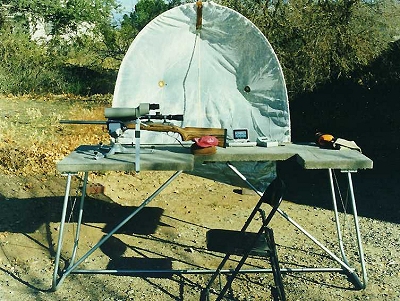This section contains brief discussions of various
ballistics and shooting related topics as requested by correspondents. If you have a
question you have been trying to find an answer to (keep 'em ballistics and shooting
related--see your minister for the mysteries of life) email me by clicking
here and I'll do my best to find the
answer for you and if it is of general interest, publish it here. If you can contribute
additional input to one of the answers I'd would appreciate hearing from you too.
Check back frequently as new topics are always being added.
On this page:
Is there a way to compute the expected weight of
lead round balls?
How can I reliably test bullet
performance?
How effective was the Blunderbuss?
Where can I get plans for a
reloading bench and a shooting bench?
What is the advantage of the full
length spring guide rods I see on many current .45 autos?
How do I scale reduced targets for practice?
What are "GO," NO-GO," and "FIELD"
headspace gauges?
What are "major" and "minor" calibers?
How accurately do "tissue simulants" relate to
bullet penetration?
What velocity is needed for a
projectile to penetrate skin?
What was the longest deliberate rifle shot by a
sniper that hit its intended target?
Why are some primers crimped into the primer
pocket?
What are your favorite calibers and favorite firearms?
What are your favorite brands of
commercial ammo in various calibers?

If someone gave you a blank check to build your
"armory" what would you get? 
Q. Is there a way to compute the
weight of lead round balls?
A. To find the theoretical weight of
an object you need to know the volume of the object and the specific gravity of
the material it is made from. Because specific gravity is measured in
grams per cubic centimeter you need to work in the metric system and the convert
the results to English units. For a sphere:
Volume of the sphere = 1.33 * pi * r3
or 4.176 * r3
Where:
pi = 3.14
r = radius of the sphere in cm (.5 * diameter in inches * 2.54
Mass = volume of sphere * specific gravity from
table below.
| Material |
Avg Specific
Gravity |
Material |
Avg Specific
Gravity |
| Brass |
8.6 |
Tin |
7.4 |
| Copper |
8.9 |
1:10 Tin/Lead |
10.5 |
| Iron |
7.5 |
1:20 Tin/Lead |
11.0 |
| Lead |
11.3 |
Tungsten |
19.2 |
| Nickel |
8.9 |
Uranium |
18.7 |
| Steel |
7.8 |
Zinc |
7.00 |
| Iron, tungsten,
nickel |
12.0 |
Bismuth, tin |
9.4 |
| Tungsten,
bronze |
12.0 |
Tungsten/polymer
matrix |
10.4 |
| Aluminum |
2.6 |
Magnesium |
1.75 |
| Antimony |
6.7 |
Titanium |
4.6 |
The results will be in grams. To convert grams to grains
multiply the results by 15.43.
As an example a .75 caliber lead ball (specific gravity =
11.34 from chart)
radius of ball = .5 * .75 * 2.54 = .95 cm
volume of ball = 1.33 * 3.14 * .953 = 3.58 cc
mass of ball = 3.58 * 11.34 = 40.6 g
weight of ball in grains = 40.6 * 15.4 = 625 grains
You can also use this information to
determine what a lead bullet would weigh if made from a different
material. As an example a 200 gr cast lead bullet would weigh 123.8 if
cast from zinc.
(specific gravity of new material / specific
gravity of lead) * weight of lead bullet = new weight = (7.0/11.3) * 200 =
123.8 gr
Q. How can I reliably test bullet performance?
A. While
the accepted standard of bullet testing is to use "ballistic
gelatin" it is not easy to produce and use in small quantities. Kind and
Knox A250 ballistic gelatin only comes in large containers (55 gallon drums)
and it needs to be mixed as a 10 percent solution using water not higher than
104 degrees F and then chilled to 40 degrees F and shot at that
temperature. It is also normally calibrated using a steel BB at a known
velocity against a calibration graph. It is a known quantity that in
properly prepared 10% ballistic gelatin a common steel BB will penetrate 8.5
cm (3.35") at 590 f/s ± 15 (180 ± 4 m/s). Using the penetration depth of
the BB a correction
factor can be applied to standardized tests but data is normally close enough
that correction factors are not needed. Click here
for information on making ballistic gelatin.
For individual use there are several
workable alternatives which can supply results that are close enough for
non-critical studies. The first is to use a row of common cardboard 1/2
gallon milk containers which are surprising uniform. Filled with water
and placed in snug contact with each other, each carton penetrated is the
equivalent of about 2.2" to 2.6" of ballistic gelatin when expanding
bullets are used. (Bullet penetration in water is 1.8 times that of
ballistic gelatin and in milk cartons somewhere generally around 1.5).
The results agree fairly closely over the velocity range of about
700 to 3000 f/s.
A second method is the "Fackler
box" which is simply a wooden frame designed to hold plastic bags full of
water. The common "ZipLoc bags work well in this
application. Because of the lack of tough cardboard between the bags one
can use the 1.8 factor.
A third method is to use "wet
pack" which is simply standard news print paper that is thoroughly soaked
with water. To ensure proper consistency several sheets of paper should be
soaked in water and then stacked in a water filled container with the fold line
alternated and the process
repeated until the desire thickness is obtained. The paper is properly
soaked when a 6" stack of folded in half newspaper (about 11.5" x
13.5" weighs about 40 pounds, when excess water has been squeezed out). Properly prepared wet pack has a
very close to 1:1 correlation to 10% ballistic gelatin as long as impact
velocities are above 600 f/s. Click here for detailed information on preparing
wet pack
Also see the article on "tissue simulants" below on this page.
A variation of wet pack that has been
suggested is to layer soaking wet sheets of corrugated cardboard in a water
filled container but I do not have a calibration factor for this material.
CAVEAT
(A big caveat)
Note that you cannot
accurately simulate the performance of a bullet at a distance by loading it to a
muzzle velocity that one would get at that distance. The reason is that
the bullet's spin decays quite slowly. As an example the M80 7.62 mm ball
round has a muzzle velocity of 2750 f/s and a 300 yard velocity of 2094
f/s. Using a 1:10 twist the bullet is rotating at 198,000 rpm
at the muzzle, but at 300 yards where the velocity is 2094 the spin has only
decayed to about 91% of the initial rpm or about 180,000 rpm. If you fire
the bullet at a muzzle velocity of 2094 f/s the bullet is spinning only at about
150,000 rpm and the bullet will behave differently than at 180,000 rpm.
Q. How effective was the Blunderbuss?
A. Not
terribly. The
blunderbuss, that familiar old flintlock firearm with the belled muzzle is a
staple of pirate movies and was considered the equivalent of the modern day riot
gun. They were not all that effective. A test was run some years ago of a
.60 caliber (at the breech) pistol with 7" barrel with a 2" flare, and
two long arms, one with a .75 caliber breech, and an 18" barrel with a 11/8"
flare, and the second with a .69 caliber breech, a 24" barrel, and a 11/4"
flare. They normally used "bore" diameter musket balls and the
historical records for the two long arms are 12 balls of .69 caliber and 120 gr
of powder for the ".69 caliber" blunderbuss and 15 balls of .75 caliber and
130-140 grs of powder for the ".75 caliber" weapon.
These weapons were fired at 40 and 60
feet at silhouette targets mounted on a 4 x 8 sheet of wall board held horizontally. Both long arms
produced lateral spreads of about 30" at 40 feet and 50" at 60
feet. Patterns were spotty and it was possible to completely miss a single
target at 60 feet. The pistol was fired at 40 feet and gave a 40"
spread but
the balls lacked so much velocity that they failed to penetrate the target
backer board at any range past about 30 feet.. It was noted that the
muzzle bell had little effect on shot spread and was most likely just an aid to
rapid loading as well as having psychological effect on the person it was aimed
at.
Q. Where
can I get plans for a reloading bench and a shooting bench?
A.
Plans for a very sturdy
reloading bench are available from the National Reloading Manufacturer's
Association. The plans can be ordered for $4.00 from
NRMA
One Centerpointe Dr. STE 300
Lake Oswego, OR
97035 |
 |
The plans are also available online in pdf format at http://www.somerssportsmen.com/bench.pdf
One modification you can make is to have slip-in inserts for your various
tools. I made my bench top from three layers of 3/4 inch particle board
screwed and glued together, and
made inserts to fit from two layers screwed and glued together. It helps
if you sand both the interior of the slots and the surfaces of the inserts,
slightly round the edges of the inserts, and then coat with a paste wax to
ensure a smooth fit. I have done case forming with this mounting system
without any problems.
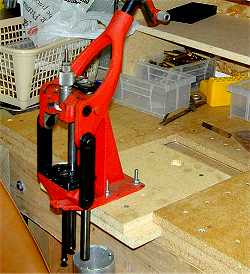
Insert partially pulled out.
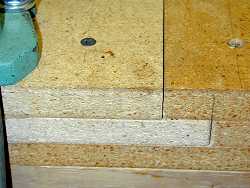 |
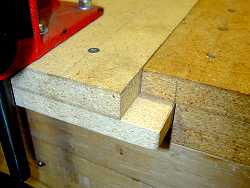 |
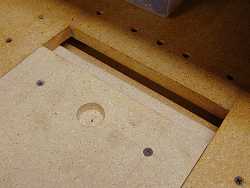 |
| Close-up of
insert fit |
Insert
detail - front |
Insert
detail - rear
(Note finger hole to help pull out) |
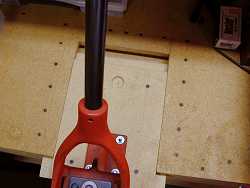 |
|
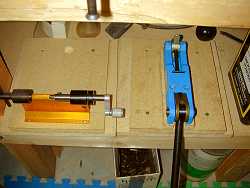 |
Top view detail
(Note reinforcing screws around edge) |
|
Extra ready to use
inserts |
Plans for a sturdy, permanent shooting bench were published in the January
1994 American Rifleman magazine. You can download these plans in MS Word (nrabench.doc
- 95k) format by clicking here.
Jim Ristow of RSI came up with a very nifty shooting bench. It takes a
little effort but it is worth it.
You can download the plans by clicking here.
Q. What is the advantage of the full length spring guide
rods I see on many current .45 autos?
A. Not much. While proponents claim
it improves the smoothness of operation that doesn't hold up under
testing. A friend used
an electronic instrumentation set-up to look in detail at the claims made by FLGR fans. Two of the test guns were ancient military
clunkers, three were el-cheapo 1911 knock-offs, two were Wilsons, three were Kimbers, two were Colts, and there
was one Les Baer.
Each gun was set-up on the bench with accelerometer sensors, and slide motion instrumentation. A high-speed laboratory
camera recorded super-slow-motion imagery of the firing sequence. Each gun had two full magazines put through it, the first
with a standard short spring guide and the second with a stainless steel FLGR
With FLGR installed in no case did the FLGR make any significant
difference that could be measured with instrumentation. None of the guns equipped with instrumentation to measure
force linearity during recoil and tested with and without FLGRs showed any
measurable difference in smoothness during actual firing.
However, when a horribly bent and kinked spring was installed, there were smoothness differences detectable
both by hand and with the instrumentation, but ONLY when the slide was being retracted MANUALLY-- not when the
gun was being fired. The forces generated during firing recoil and imparted to the mass of the slide
vastly overwhelmed any small roughness from the kinked spring.
Keep in mind that with a standard (short) spring guide, that the spring is fully contained on the guide when the
slide is retracted.
As to claims that the FLGRs add weight and reduce muzzle climb,
consider how much they weigh. I don't think so.
And... they negate one of the advantages of the 1911
design--the ability to completely disassemble the pistol without any tools (a
problem further exacerbated by the current fad of using Torx-head or Allen-head
screws and other parts that deviate from the original specs. The original
design was such that the lip on the sear spring could be used as a screw driver
to remove the grips and the magazine catch, the shaft of the safety as a punch
to remove the mainspring housing, and the hammer strut could be used
as a pin punch (something you can't do with the current square struts).
Q. How do I scale
targets for practice at reduced distances
A.
If you simply reduce a full
sized target to 1/3
its normal dimensions you can then use distance in feet as distance in
yards for your practice. This works well indoors for dry firing targets.
(See the Safety page for info on safe dry firing
procedures.) Click
here for a 1/3 scale silhouette target for dry firing or sub-caliber
practice in MS Word format.
To scale a target for different full ranges use the following
formula.
reduced size in inches = (reduced range
in yards / real range in yards) * target dimension in inches.
As an example suppose you want to
simulate a 400 yard shot on an 18" x 30" silhouette at 250 yards
(250 / 400) * 18" = .625 * 18 =
11.25"
(250 / 400) * 30" = .625 * 30 = 18.5"
Thus use an 11.25" x 18.5"
target at 250 yards to simulate 400 yards.
The following chart gives target size
for several simulated distances.
|
Scaled
Target Dimensions at Different Distances
(Based on an 18" wide target)
|
|
To Simulate
|
Target width at 25
yd
|
Target width at 50 yd
|
Target width at 100 yd
|
|
50
|
9”
|
--
|
--
|
|
100
|
4.5”
|
9'
|
--
|
|
200
|
2.25”
|
4.5'
|
9"
|
|
300
|
1.5'
|
3"
|
6"
|
|
400
|
1.125'
|
2.25'
|
4.5" '
|
Q. What are "GO,"
NO-GO," and "FIELD" headspace gauges?
A.
These headspace gauges set the minimum, maximum, and
end-of-life chamber lengths. The bolt must close completely on a
"Go" gauge (minimum chamber), bolt should only partially close, if at
all, on a
"NoGo" (maximum chamber) . The "Field" gauge sets the
absolute maximum allowable for worn weapons and the bolt should not close on it.
If it does it's time to replace the barrel.
Nominally the No-Go is .004" -.006" longer than the
Go and the Field is .008" - .010" longer than the Go gauge.
Q. What are "major" and
"minor" calibers?
A.
In the early days of practical
pistol shooting (before the win at any cost gamesmen came on the scene) scoring
was partially based upon the power of the pistol being used, since in the real
world the power has an effect on the on target performance. Two power
floors were established. "Major" was based on the .45 ACP round with a
230 gr GI load (nominally 230 gr @ 820 fs) out of a Colt Commander and "minor" was based on the 9
mm "GI" round with a 124 gr bullet (at about 1120 fs) from a Browning Hi-Power.
Two methods of measuring performance
were used. The first was a ballistic pendulum which was calibrated using
factory ammunition. Ammunition which moved the pendulum as much as or more
than a 9 mm test round, but less than a .45 test round were classed as minor and
scored 5, 3, 2. Ammunition which moved the pendulum as much as or more
than a .45 test round were classed as major and scored 5, 4, 3. The second
test method came about when chronographs became available. Sample rounds
were fired over a chronograph to obtain the velocity and the velocity was
multiplied by the bullet weight and the divided by 1000 to get a
number.
The original major number was 175 and the
original minor floor was 125. The accepted values have changed over the years as
gamesmen took over the sport and started to use lighter loads to beat
recoil. Within IPSC power factors have become irrelevant because they now
change according to the class shot in. For "open" class the
factors are 160/125, for "standard" they are 170/125, and for
"production" major is considered 125 with no minor category. Use
of the current categories has no relevance
to the real world at all since it changes with the class. It's become an
aid to gamesmen in winning.
A modification that has been suggested
by some is to add a scoring factor based on the diameter or area of the bullet
used. While different factors have been suggested probably the easiest is
one that multiplies the competitor's score by 1.1 for bullets of .40 cal or
larger. Of course if you aren't a gamesman this is all moot.
Q. How accurately do "tissue
simulants" relate to bullet penetration?
A.
The table below shows the
differences in performance of various tissue simulants.
| Simulant |
Penetration |
| Leg of freshly killed swine |
8.8 ± 1.6 cm |
| 10% Gelatin at 4° C |
8.5 ± 0.4 cm |
| 20% Gelatin at 4° C |
4.4 ± 0.2 cm |
| 20% Gelatin at 20° C |
8.0 ± 0.2 cm |
| Wet pack (@> 600f/s) |
8.4 ± .5 cm |
| Swedish soap at 4° C |
4.2 ± 0.3 cm |
| Swedish soap at 20° C |
5.8 ± 0.4 cm |
| Calibration done
using the standard .171" "BB" at 590 ± 15 f/s |
While I don't have similar data using the same standard as the table above
for water, penetration in water is about
1.5 -1.8 times greater
than 10% ballistic gelatin.
For information on gelatin preparation click here.
For information on wet pack preparation click here.
Data from Bullet Penetration: Modeling the
Dynamics and the Incapacitation Resulting from Wound Trauma, by Duncan
MacPherson. Date on wet pack from personal notes.
Q. What velocity is needed for a projectile to penetrate
skin?
A. Tests done by several research groups
using projectiles of various diameters and shapes (ranging from .17 cal airgun
pellets to .45 cal bullets) report that a velocity of between about 180 to about
360 f/s is needed. The wide range comes from the non-uniform strength of
normal skin tissue. Interestingly, projectile shape had no statistically significant
effect on the penetration effect. Keep in mind that one could still be
injured even if the projectile does not penetrate the skin.
Data from Bullet Penetration: Modeling the
Dynamics and the Incapacitation Resulting from Wound Trauma, by Duncan
MacPherson
Q. What was the longest deliberate rifle shot by a sniper
that hit its intended target? 
A. As of June 2017 the record is 3450 meters
(3,773 yards) by a Canadian in sniper in Iraq, using a McMillan TAC-50. The
old current record was 2815 meters (3078 yards) by an Australian sniper team in Helmand Province,
Afghanistan, in 2015, using 2 Barrett M82A1 .50 cal rifles fired simultaneously.
Until then the record was taken in
2004
by a Canadian sniper who used a .50 cal McMillan TAC-50 bolt action to kill a
Taliban in the Tora Bora region of Afghanistan at a measured 2429 meters (2657 yards).
In addition, in November 2009 a British sniper using a .338 Lapua L115A3 rifle scored a double kill at 2475 meters (2707 yards). Honorable mention goes to Carlos Hathcock in Duc
Pho, Vietnam who used a tight .50 cal M2 machine gun fitted with an
Unertl scope and firing single shot to hit a VC at a range of about 2500 yards,
but he admitted that the hit was probably more luck than skill. The
problem with very long range shots isn't so much the bullet's trajectory as it
is wind drift. Wind direction and speed can change several times over long
distances. Even in 1000 yard competitions it is not unusual to see the
wind flags pointing in opposite direction down range.
Update 2018-07-31: As of this date the current long range hit record
was shot on September 30th, 2017, by Charlie Melton, a retired United States
Navy SEAL sniper, He hit a 40-inch target at 5,000 yards, smashing all previous
records.
Q. Why are some primers crimped into
the primer pocket?
A. Crimping of primers is done primarily on
military ammunition for the purpose of reliability with automatic weapons, to
prevent the primer from backing out under conditions of harsh handling or sloppy
headspacing, which could lead to a malfunction. There are four basic
primer crimp types as shown below.
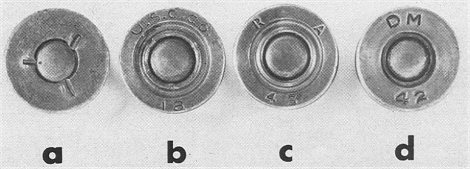 |
|
A - Stab crimp, B -
Circular stake crimp, circa WWI, C - Circular stake crimp, circa WWII,
D - US Military crimp |
What are your favorite calibers and favorite
firearms? 
A. This is one of
those questions that fights start over, but I get asked it so frequently that I
guess I'll take a stab at it. Your choices may be different but I'm happy
with mine
My caliber choices are based primarily on factory
production, utility and availability but a couple (.22TCM, .41 Police, .376 Steyr, and
.460 A-Square) are on the list just because I think they are example of well
though out cartridges.
| Favorite
Handgun Cartridges |
| Handgun Ctg |
Comments |
| .22RF |
The "universal"
cartridge |
| .22TCM |
Basically a shortened .223
case necked to .22 caliber with an OAL of 1.26" this round is what
the 5.7 x 28 FN round should have been. Chambered in 1911 style pistols
it will run a 40 gr projectile at 1900 from a 5" barrel.
Might be interesting in a small rifle too. |
| .256 Winchester |
A very nifty and under
appreciated cartridge |
| 6.5 x 25 |
In "military" trim
runs a saboted 4 mm 31 gr tungsten projectile at at 2400 from a 5"
bbl and with a bbl swap will work in typical 9 x 19 mm weaponry |
| 9 x 19 mm |
Particularly in the 124 and 135 gr
loadings this is the equivalent of the .38Spl +P loads for use in very
compact 9 mm pistols as a hideout pistol similar in concept of the
S&W 5-shot revolvers |
| .38 Super |
While called a +P round it
really isn't and runs at the same pressures the standard 9 mm
does. Loaded to 38.5 Kpsi like the 9 mm +P it would be a dandy
round in modern pistols. (Which is basically what the 9 x 23 mm round
is. |
| .357 Mag |
Moderately powerful revolver
round of great versatility, with ability to use .38 Spl cartridges.
Thanks to modern metallurgy there is no reason to chamber a revolver
solely for the .38 Spl ctg. It is very nifty in a lever action
carbine. |
| 10 mm ACP
(10 x 25) and .40 S&W |
The 10 mm is a very powerful and flat
shooting auto pistol cartridge is also available in a lower velocity
loading which was the basis of the .40 S&W. The .40 S&W
round offers adequate performance at the expense of running near the
cartridges upper limit. For use in a compact or 9 mm framed pistol the .40 S&W is an
acceptable choice though. |
| .41 S&W Mag |
Primarily the now obsolete
"police" loading of a 210 gr LSWC bullet at about 950 f/s
which was the ideal police revolver round when combined with the S&W
M57/58 revolver |
| .44 Spl |
Nicely balanced cartridge of
excellent controllability and power |
| .44 Mag |
Powerful enough for anything
that needs to be done with a handgun with great versatility. |
| .45 ACP |
THE auto pistol round for self
defense, accurate, powerful, and versatile. The new .45 GAP gives
about the same level of power in a slightly smaller package by running
at .45ACP +P pressures. in the standard loading but it is not as versatile
as the ACP. |
| .45Auto Rim |
Most of the power of the big .45 Colt
in a compact package for revolvers |
| Favorite
Rifle Cartridges |
| Rifle Ctg |
Comments |
| .22 RF |
The "universal"
cartridge |
| .22 Hornet or K-Hornet |
A nifty .22 center fire round
of adequate power, especially in the wildcatted K-Hornet version. In a well made compact rifle it is just the
ticket when you need more power than a .22 RF without a lot of
noise. Rimless versions would be nifty. |
| .221 Rem Fireball |
While designed as a
"pistol" cartridge for the Rem XP100, this round has a lot of
untapped potential as a rimless successor to the Hornet in rifles |
| .223/5.56 NATO |
Current GI cartridge capable of excellent accuracy and decent ranging. |
| .22-250 |
A very accurate .22 centerfire
capable of excellent accuracy way out there. What the world needs
is a 1:9 to 1:8 twist barreled .22-250 to handle the 69-77 gr bullets. |
| .243 Win |
An adequately powerful and
versatile round idea for recoil sensitive shooters. Most factory
rifles use too slow a twist for good performance with 100 gr + bullets
which really need a 1:9 twist or faster. |
6.8 mm SPC
(6.8 x 45 mm) |
This small and very well
balanced cartridge is capable of outstanding performance in a properly
chambered barrel and is suitable for a wide variety of medium game
animals |
| .280 Rem |
A flat shooting round that
with careful loading and 145 gr or less weight bullets can approach the
7 mm Mag in performance while being easy on the bore and your shoulder. |
| .30 Carbine |
Generally considered a weak
round but with modern expanding bullet this is a nifty caliber. |
| .308 |
Current GI cartridge and
basically the GI .30-06 in a shorter package which allows its use in
shorter rifles. Only drawback is it's inability to use 200 gr+
bullets and it performs best with 168 gr and lighter bullets due to the
default 1:12 twist in many rifles. |
| .30-40 Krag |
While this rimmed cartridge is
obsolete it is capable of taking any game in North America and with the
nostalgia of the Krag rifle is just a fun cartridge. |
| .30-06 |
The most versatile rifle round
made |
| .350 Rem Mag |
Basically the .35 Wheelan in a
short package for use in compact rifles. Powerful enough for
anything in North America. |
| .35 Wheelan |
One of the best medium bores
for use in .30-06 length actions. |
| .376 Steyr |
95% of the .375 H&H in a
.30-06 length case. |
| .375 H&H |
The "great medium
bore" round. Very versatile and accurate |
| .416 Taylor |
This is a .416 diameter bullet
on the .338 Win Mag case and is a nicely balanced medium heavy cartridge
for heavy game. I've always lusted after a rifle in this caliber. |
| .45-70 |
In modern high pressure
loadings as produced by Garrett Ammunition this is THE big bore lever gun cartridge, plus it has a great
nostalgia factor. |
| .460 A-Square Short |
Better balanced than the .458
Win Mag it gives outstanding performance without the squirrelly pressure
problems of the .458. |
|
Favorite Handguns |
| Handgun |
Comments |
| Ruger MKII |
Relatively
inexpensive and accurate pistol with a nice "feel." |
| S&W .22/32
Kit Gun |
Nifty,
light weight .22RF revolver built on the J frame. How about one on
a Scandium frame? |
| Colt or other .22RF conversion unit for the 1911 pistol |
Great
training aid and they can be surprisingly accurate. I prefer the
Colt unit with its floating chamber because it simulates the 1911's
recoil better, especially when mounted on a dedicated aluminum frame. |
| Colt
1860 Army .44 |
To
my mind this is one of the most beautiful pistols ever made. |
| M&P
Full Size V1 & 2 |
What
Glocks should have been |
| M&P Shield V1 & 2 |
In 9 mm it's a higher capacity
"J" frame. Very flat. In .45, just a little fatter |
| S&W 340, 640,
649 |
These
5-shot compact revolvers are the choice for a pocket pistol for those
wanting a wheel gun |
| S&W M58 round
butt |
This
.41 Mag revolver is the big bore equivalent to the round butt .38 Spl
M10 and just a nice looking revolver. |
| Ruger GP100 .357
revolvers |
Rugged
and easy to tune medium frame revolvers that are seemingly indestructible |
| Ruger Redhawk .44
Mag |
A
very rugged and reliable (and to my eye good looking) .44 Mag
revolver. A tack driver. (The good looks don't apply to the
butt-ugly Super Redhawk.) |
| 1911 series auto
pistols |
In
either standard, Commander, or "Officer's length. My
preference is for Ruger, Kimber, Springfield, or S70 and earlier Colts. |
| Browning P-35
"High Power" |
THE
Heavy duty 9 mm--especially with the old "burr" hammer |
| FN FNP Pistols |
Very
nice hammer fired pistols in 9 mm, .40 S&W, and .45 ACP. The
.40 is especially nice. |
| Steyr M-A1 |
A
very odd looking striker fired pistol in 9 mm and .40 that is one of the
best feeling pistols in my hand. |
| H&R
"Handy Gun ,410 |
This
neat single shot, break action smoothbore pistol was the first handgun I
ever shot. Just plain nifty. Classed as an "any other
weapon" so it requires ATF approval and a tax stamp these days |
| H&K
MP7 PDW |
Other
than it's tiny 4.35 mm round this locked breach PDW is very nifty and
handy. In .22TCM or 6.5 x 25 it would possibly be the ideal PDW. |
| Favorite
Rifles |
| Rifle |
Comments |
| Ruger 10/22 |
A
fun plinker |
| Savage Mk II
FV-SR |
An
inexpensive and scarily accurate bolt action, with Savages "Accutrigger"
and a threaded muzzle |
| Kimber .22 RF |
Simply one of the nicer premium
.22 rifles |
| Winchester M70
Classic |
The
classic controlled feed rifle. If I could have only one rifle it
would be this in .30-06 |
| Ruger M77 |
I
just love the looks and all that I have owned have been tack drivers
(after a little work) |
| M1 Carbine |
Light,
handy, fun to shoot and with the WW 110 gr JHP or other modern expanding
loads is quite effective on small
game and as an antipersonel weapon (does not apply when using FMJ ammo) |
| Ruger Mini-14 |
Very neat and
handy M14 style 5.56 mm, 6.8 mm, 7.62 x39 mm carbine. Surprisingly
rugged. Many older ones have some accuracy issues but the fix is
easy. |
| M1 Garand |
What
can I say |
| M14/M1A |
Especially
the 18" bbl "SOCOM" version |
| M4 Carbine |
The
current GI battle carbine. Handles well, reliable, and its use
should be familiar to all citizens. Particularly nifty with the 75
and 77 gr ammunition or in 6.8 mm |
| SIG 556 |
Very
nice 5.56 battle carbine with amazing triggers. My minions will be
armed with these in 6.8 mm |
| Steyr Scout |
Neat,
handy, super accurate, and cutting edge |
| Savage Scout |
About
90 percent of the Steyr Scout at 1/3 the cost |
| Marlin 1895 |
In
either .30-30 or .45-70 it's THE lever rifle |
| Marlin 94 |
In
.357 Mag this is a very under appreciated rifle |
| M1898 Krag |
Classic
looks (especially the carbine) and the smoothest action
ever. The "old" .30-40 ctg will take anything in North
America if you do your part. |
| Barrett M82/M107 |
Big
.50 BMG semi-autos that are a blast to shoot and quite accurate. |
| Winchester
1892/1894 |
These
classic lever action rifles are just really good looking. The '92
is the pistol cartridge version |
If I had to build a "battery" I'd do it as follows.
| Number
Allowed |
Rifle Battery |
Pistol
battery |
| 1 |
.30-06 (.308 would also work
in place of a .30-06 but should have 1:10 twist to handle bullets
greater than 168 gr |
.357 Mag mid frame revolver |
| 2 |
.22RF
.30-06 |
22RF auto, and either a .357 Mag mid frame revolver or 1911 auto
and .22 conversion |
| 3 |
.22RF
.30-06
.376 Steyr or .375 Ruger |
.22RF auto
9mm/.40 compact auto
1911 |
| 4 |
.22RF
.223
.30-06
.376 Steyr or .375 Ruger |
.22RF auto
9 mm/.40 compact auto
.357 Mag mid frame revolver
1911 |
| 5 |
.22RF
.223
.30-06
.376 Steyr or .375 Ruger
.460 A-Square Short |
.22RF auto
9 mm/.40 compact auto
.357 Mag mid frame revolver
1911
.44 Mag revolver |
| 6 |
Same as "5" with the
addition of a battle rifle M1A/AR-15 |
Same as "5" with the
addition of a compact 1911 |
I was recently chastised for omitting a shogun from the battery or having a
"shotgun battery." Oops! Not being either wealthy nor a
"collector" I tend to try to limit things to those that are truly
useful so I don't see making a shotgun "battery." I would recommend the
inclusion of a 12 gauge pump or semiauto shotgun (I'd probably choose a
Remington 870, 11-87, or a Mossberg 590, 930,) configured with two barrels. An 18" or
20" rifle sighted barrel for defensive use and a 24" ribbed barrel
with either an adjustable choke or choke tubes for hunting. (Why
24"? Because longer barrels offer very little increase in velocity or
range with typical ammunition and the 24" barrel makes the shotgun very
fast handling in the field.)
And just to round things out, here's a list of cartridges I wish they would
popularize, reintroduce, or make, and a short list of some improvements to existing firearms
or new firearms I'd like to see.
| Cartridge |
Comments |
| .22 TCM |
This short, .223 case based
round, will fit in a 1911 frame and is what the 5.7 x 28 should have
been. While it is produced it hasn't gotten the popularity it
deserves. |
| .22 Hornet / K-Hornet Rimless |
All the fun of the Hornet in a
rimless case for better feeding in bolt action rifles. Of course the
.221 Rem Fireball would do this job nicely too and has a .223 case
diameter but hey, everyone's introducing new cartridges. |
| .25 Rimfire 60 gr |
Loaded to .22WRM pressures
this would be a nice alternative to the .17 RF rounds for those who
prefer heavy bullets. |
| 6.5 x 28 |
A slightly longer version of
the 6.5 x 25 for even better ballistics with saboted and non-saboted loads in PDWs. |
6.8 x 43 mm SPC +P or
6.8 x 45 /6.8 x 47 mm |
Well not really a +P but
loaded to the original GI performance of 115 gr at 2700+ f/s for use in
GI, SPC II, and DMR chambers. (Hornady "super-performance??)
A 45 or 47 mm case would really be interesting but wouldn't fit current AR
platforms. |
| 30 carbine 95 or 100 gr JHP |
With a properly constructed
and shaped 95 gr bonded core JHP bullet at 2200 f/s this (along with the WW
and other 110 gr JHP load) would make nifty
small game, home defense, and
police carbine rounds for the handy M1 carbine |
| .30-06 250 gr |
For where deep penetration is
desired |
| 9 x 23 |
This extremely powerful round
gives real .357 mag performance in a 1911 compatible case.
Basically a true rimless .38 Super with a much stronger case it runs
safely at rifle like pressures. Why it isn't a major player mystifies
me. |
| .357 Maximum |
This cartridge would come into
its own in a Marlin 94 |
| .401 WSL +P |
A modern high pressure version
of the old .401 Winchester Self Loading cartridge. The original
round was a little weak for its size (200gr @2130 and a 250 gr @ 1870) running at
around 35K CUP. Loaded
to a realistic modern pressure level of say 45-50 K psi some interesting
performance (close to a 200 gr at 2400) could be achieved in a compact rifle. |
| .41 Special Police 180-200 gr
JHP |
A similar round to the .41 Mag
police round but with a shorter case of .38 SPL length, for use in a
non-magnum capable service revolvers. |
| .45 Auto Rim 200-230 gr JHP +P |
The true power of the .45 Colt
in a more compact package |
10 mm ACP Magnum
(a.k.a.10 x 31 mm) |
A longer cased 10 mm ACP round
(like the Winchester .45 and 9 mm Magnum rounds) for use in semi-auto
carbines. A 180 gr @ 1800+ from an 16" bbl carbine would be nifty.
While it has been produced in very limited quantities some good
marketing would help. |
| Reduced loading rifle
cartridges |
Loaded with either light
weight jacketed or lead bullets at velocities of about 1150 f/s for use
as quiet plinking or training rounds. Similar in concept to the
old military "guard" or "gallery" loadings. |
| Firearm |
Comments |
| CB Cap chambered .22 rifle |
A small rifle specifically chambered for
the tiny CB Cap .22RF with an appropriate twist barrel. Fun and
almost no noise. |
| J-Frame S&W fixed sight revolvers |
Make a slight raised "hump for
the rear sight so the notch could be a bit deeper for a better sight
picture. How about a blackened face on the rear sight on stainless
steel pistols while we are
at it. |
| 10 mm Mag M1 Carbine |
Just plain nifty in 10 mm Mag |
| Savage, Remington, and Winchester, &
Ruger detachable mag rifles |
How about real 5 and 10 rd double column box mags. |
| Savage, Remington, and Winchester actions |
How about a true "tiny" actions
scaled to .223 and smaller sized ammunition |
| 1:10 or 1:11 twist .308 Win barrels as
standard |
The standard .308 Win twist is 1:12 and based
on the GI spec for 150 gr bullets. It is barely adequate for bullets
over 168 gr. Some manufacturers have seen the light recently. |
| Savage 110s offered with two barrels |
The Savage system lends itself to easy
barrel swapping. Could even supply two bolts to take standard and
mag cased ammo. How about a Savage scout with .308 and .358
barrels or even a .350 Rem mag barrel and bolt? |
| All autopistols |
How about including 3 spare magazines (1
in the gun and 2 spare) in the box |
| .22 RF bolt action rifles |
How about decent looking stocks on
inexpensive .22 RF rifles. Doesn't have to be fancy wood, just
something that looks like a stock on a center fire rifle instead of an
after thought chewed out by drunk termites on crack. |
| Shotguns |
How about offering 24" ribbed barrels
for field work with either an adjustable choke or choke tubes. You
lose very little in ballistics and have a very fast swinging shotgun |
| .308 Enfield conversion kits |
The British Enfield rifles are rugged and
reliable but hampered by ammo availability. Conversion kits to
.308 Win (barrel, magazine, ejector, and bolt head) were common in the
UK but seldom seen here. There are lots of No. 4 and No. 5 rifles
in circulation that could use these kits. |
Two follow-on questions related to this topic.
First, the question was raised "what would be your
minimum ammunition selection." The answer to that question depends on
just what your goals were. If you were stocking up for a long term disaster scenario
I would recommend that you stick to commonly available calibers kept in several
caches in different location.. These
would include: .22RF, 5.56 mm (.223), 7.62 mm (.308), .38SPL/.357, 9 mm,
.40S&W, .45 ACP, and 12 ga. You could add some boxes of whatever
calibers calibers are common to your area to be complete. The .380 ACP might be
an addition as trading stock. When ammo becomes scarce, a box of .32
Winchester for your neighbor's rifle might be worth several meals or a bunch of
supplies. And don't forget a supply of detachable magazines where
appropriate.
Second, the question was raised what firearms would be my choice for an
EOTWAWKI (end of the world as we know it) battery. There are all kinds of
"experts" out that who recommend all kinds of esoteric arms. But consider
this: when there is no resupply where are you going to get parts and magazines
for your $2200 esoteric battle rifle or pistol? I strongly suggest that
you stick with weaponry and calibers that are common police, military, or
sporting models, so parts will be available as pickups.. For battle rifles
this would include M1, M1A (M14), AR15 (M16), M1 Carbine and possibly the
Mini-14 Ruger and AK47 (just because they are common these days). For handguns
the M1911 series, Glock and S&W M&P autopistols, and S&W &
Ruger revolvers. For
shotguns the Rem 870 and 11-78/1100, and the Mossberg 500/590/930. For
sporting rifles the Rem 700, Win M70, Ruger 77 series, and Savage 110/111, Win
94, Marlin 336. If you simply must have an esoteric arm ensure that you
have at least 1 complete set of depot level repair parts for it in a
safe and accessible cache.
And to round things out, there are a number of firearms that I just like the
way they look. Among these are the 1860 Colt Army .44 cap & ball, Krag
1896 carbine, 1911 pistols, S&W M&P, Winchester M94, Ruger M77 rifles,
M1 carbine, S&W 3" J-frames, Colt 1873 Peacemaker, Ruger 5" Red
Hawk, and probably some others that I'll remember later.
Q. What are your favorite brands of commercial
ammo in various calibers?
A. This is another question that
blood is spilt over. For pistol calibers my go to is Hornady, especially
their "Critical Defense" line followed by Federal and Winchester, with Speer "short barrel loads for revolvers.. In both case
their "LE" or "duty ammo." In rifle calibers its
Hornady and Federal, and shotgun is Federal.
Q. If someone gave you a blank check to build your
"armory" what would you get?
A. Being rather practical I'm not into buying vast
quantities just because I can. If given such an opportunity to go nuts I'd
probably go by calibers thusly.
- .22RF - S&W .22RF "Kit Gun," Ruger MK4 .22 Auto, .22
conversion for the 1911 pistol, Savage MKII Rifle, Ruger 10/22
- .223/5.56 - Barrett 416 (also one in 6.8 SPC)
- .380 ACP - Ruger LCP II, Browning .380 "1911"
- 9 mm - S&W V2 M&P, S&W Shield V2, Browning P35, FN X
- .40S&W - FNX, S&W M&P V2
- 10 mm ACP - 1911, Glock 20
- .357 - S&W 649, Ruger GP100, Marlin 1894
- .44 Mag - Ruger RedHawk 71/2" , Ruger GP100
.44Spl
- .45 ACP - 3.5" 4.25" and 5" 1911, FNX-Tactical, S&W
M&P V2
- .30 Carbine - M1 Carbine
- .45-70 - Marlin 1895
- .308 - M14, M14 SOCOM, AR10,
- .30-06 - M70 "controlled feed" Custom, or ditto Ruger 77, M1 Garand
- .22-250 - M70 "controlled feed" Custom, or ditto Ruger 77
- .375 Ruger -M70 "controlled feed" Custom, or ditto Ruger 77,
- .460 G&A - M70 "controlled feed" Custom, or ditto Ruger 77
- 12 ga - Ruger Red Label, Rem 11-87 with mutiple barrels, Mossberg 930
Combat
- Suppressors for .22RF, 5.56, .308, 9 mm, and .45 ACP
- .50 BMG - Barrett
and all the ammo I could get for the above.
Please email comments to Fr. Frog by clicking
here.
| Back to Q&A Index | Ballistics Main
Page |
| Back
to Fr. Frog's Home Page |
Disclaimer
As far as I know all the information presented above is
correct and I have attempted to ensure that it is. However, I am not responsible for any
errors, omissions, or damages resulting from the use or misuse of this information, nor
for you doing something stupid with it. (Don't you hate these disclaimers? So do I, but
there are people out there who refuse to be responsible for their own actions and who will
sue anybody to make a buck.)

Updated 2020-08-12







